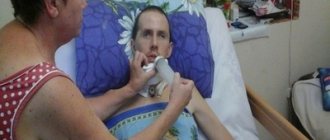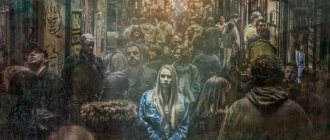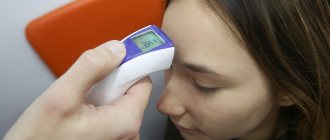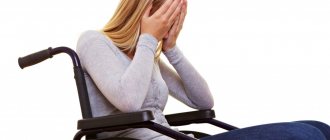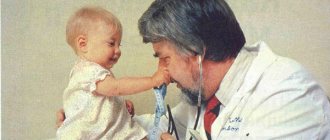Muscular neurosis is a disease that occurs against the background of neurotic disorders, manifested by pain and muscle tension in the absence of organic damage to muscle tissue and adjacent structures. As a rule, it affects a certain area (face, back, neck, limbs) and is combined with vegetative-vascular disorders.
Call and make an appointment for a consultation by phone. 8(969)060-93-93.
Causes
The immediate cause is constant muscle strain that occurs when negative experiences are repressed. Provoking factors are considered:
- chronic or intense acute stress;
- OCD and anxiety-phobic disorders;
- asthenic neurosis;
- neurotic depression;
- hysteria;
- somatoform disorders.
Negative experiences cause increased production of stress hormones, which, in turn, increase muscle tone. This is compounded by other factors, for example, the need to clench your teeth when you endure the unbearable, the habit of raising your shoulders in anticipation of a blow (including an emotional one, not a physical one) or holding back aggression. Tension is aggravated by autonomic dysfunction, which provokes muscle spasms.
A significant role is played by dissociation with the body - a state when a person, due to constant mental discomfort, attaches less and less importance to physical signals, as a result, sits or stands for a long time in an uncomfortable position, without noticing it. Maintaining a static position requires the participation of certain muscle groups, which subsequently go into spasm, which also goes unnoticed until some point.
VSD and panic attacks are disguised as cervical osteochondrosis.
VSD (vegetative-vascular dystonia) is one of the most tricky diseases. VSD and accompanying panic attacks are often disguised as cardiovascular, mental and other health problems. Vegetative-vascular disorder is associated with disturbances in the functioning of the autonomic nodes of the nervous system. These nodes (ganglia) are responsible for the normal functioning of almost all functions of our body: blood circulation, respiration, digestion, reproduction, excretion, metabolism and growth. Therefore, if there is a malfunction in their work, then a general malaise occurs, the variety of components of which ranges from headaches to disorders of the gastrointestinal tract, from mild weakness to a state of loss of consciousness. With VSD and panic attacks, a person does not understand what exactly is hurting him, and numerous examinations do not reveal any pathologies.
In addition, vegetative nodes are located throughout the body, and if they are unhealthy, then a person immediately feels tension or pain in the very part of the body where the unhealthy node is located. That is, if the nerve node in the cervicothoracic region does not work correctly, then first of all this will affect the muscles of the neck. And the first thing the patient will think about is “cervical chondrosis.”
Therefore, if you have a sore neck or are already experiencing panic attacks due to cervical osteochondrosis, then the problem is precisely that VSD, panic attacks and other symptoms are disguised as the so-called “cervical osteochondrosis.” Surprisingly, even such a common component of VSD as panic attacks is beginning to be misinterpreted as a sign of problems with the spine.
Understanding how the autonomic nervous system works also explains why neck pain typically occurs long (perhaps several years) before panic attacks occur. And with the development of panic disorder, patients often complain that neck pain (“cervical chondrosis”) begins to bother them right before a panic attack!
Now it becomes clear why outdated methods of treating cervical osteochondrosis and panic attacks do not bring the long-awaited results, and people live for years with symptoms of cervical osteochondrosis and panic attacks! It’s just that the treatment is aimed completely at the wrong area where it should be - at cervical osteochondrosis and the spine, and not at the VSD and the nervous system.
Classification
Taking into account the preferential localization, the following types of muscle neurosis are distinguished:
- Facial. The facial and chewing muscles are involved.
- Chest. Symptoms resembling intercostal neuralgia are observed.
- Cervical. Respiratory disturbances are noted, and a lump may appear in the throat.
- In the spine area. The cervical and lumbar regions are most affected. Sometimes the pain spreads along the entire spinal column.
- In the area of the limbs. Manifestations are variable, most often one or both paired limbs (upper or lower) are affected.
Cervical osteochondrosis, VSD and panic attacks. Treatment.
People with VSD and panic attacks due to cervicothoracic osteochondrosis often do not know where and how it is treated. Patients undergo courses of massage, acupuncture, psychotherapy, take courses of medications, etc. But at best, it only provides temporary relief from the symptoms of muscle tension and panic attacks. It is important to understand that with “cervical osteochondrosis”, VSD and panic attacks, the symptoms of pain in the neck and back are caused by persistent muscle spasm of the deep muscles of the neck, which the massage therapist’s hands cannot reach, and therefore no massage can solve the problem. And the root cause of pain and panic attacks with VSD and “cervical osteochondrosis” will not be eliminated.
Since the cause of muscle pain and panic attacks during VSD is actually not related to cervical osteochondrosis, treatment should be aimed at the nervous system. The impact of the treatment must be quite deep and powerful and at the same time very careful and precise. Among modern methods of traditional medicine, there is a unique technique that meets these requirements - laser treatment: intravenous laser therapy with red or blue lasers and infrared laser therapy of the skin projection of excited autonomic ganglia.
One of the few places that can offer such treatment and where they have been effectively helping to get rid of panic attacks, VSD and “cervical osteochondrosis” for more than 20 years is the Clinical Center for Autonomic Neurology. The clinic's doctors are qualified neurologists-vegetologists who specialize in the treatment of VSD and panic attacks. If you are diagnosed with “cervicothoracic osteochondrosis”, you can contact us, we will conduct a thorough diagnosis of the state of your autonomic nervous system, and treatment will be aimed specifically at eliminating the source of the disease, that is, returning the nervous system to harmonious functioning, which will relieve you of all symptoms cervical osteochondrosis, VSD and panic attacks.
Symptoms
The patient complains of constant tension and muscle spasms. Sometimes there are sensory disturbances - paresthesia and hypoesthesia. In the first case, the patient is bothered by unusual sensations in the affected area that are not associated with the action of real stimuli. In the second, there is a decrease in sensitivity.
The pain is perceived as deep, at first minor, then moderately intense. At first they only bother you during exertion, then they remain at rest. Sometimes they simulate pain in various diseases, for example, heart pathologies, diseases of the musculoskeletal system, and nerve damage. With a long course, the range of movements decreases, but there are no atrophic changes.
Along with the symptoms listed above, dizziness, headaches, and tinnitus are often observed. Autonomic disorders are manifested by hyperhidrosis, palpitations, unstable blood pressure, and discomfort in the abdomen. Neurotic symptoms are determined by the underlying disease. Common signs are emotional lability, irritability, anxiety, fatigue, apathy or, on the contrary, increased excitability. Sleep and appetite disturbances are often detected.
VSD and cervical osteochondrosis – what to treat?
Are you worried about neck pain? Against the background of constant pain, have you developed increased anxiety, weakness, tearfulness, insomnia and sensitivity to changes in atmospheric pressure? Or maybe you are already experiencing unexpected attacks of rapid heartbeat, numbness in the arms and legs, panic attacks and other symptoms of VSD and cervical osteochondrosis?
If you come to the doctor with such complaints, then most likely you will be diagnosed with “cervical osteochondrosis” and will be recommended to move more, do exercises, undergo a massage course, and if you have complaints of panic attacks with cervical osteochondrosis, you will definitely be prescribed medication.
In addition, if a person is bothered by the above symptoms, then along with and even instead of a diagnosis of osteochondrosis, the patient may be given VSD (vegetative-vascular dystonia), because the symptoms of the two diseases suspiciously coincide.
If you become the unfortunate owner of both diagnoses, then the number of pills you use will double. But will all these methods help get rid of constant pain and panic attacks with cervicothoracic osteochondrosis? Ultimately, many patients discover that they are “incurable.”
Therefore, before taking medications “for all diseases,” you should ask a number of logical questions: what comes first and what exactly needs to be treated – VSD and panic attacks, or cervical osteochondrosis? Why are the symptoms the same, but the treatment is different? How to distinguish VSD and cervical osteochondrosis? We will try to find answers to all these questions.
Diagnostics
Making a diagnosis can be difficult due to the variety of symptoms and similarities with other pathological processes. Along with psychologists and psychiatrists, orthopedists, neurologists, maxillofacial surgeons and other specialists are involved in the examination, depending on the location of painful sensations. The disease is diagnosed after excluding organic disorders.
In the process of differential diagnosis, a neurological examination, electromyography and other studies are performed. Most often, muscle neurosis must be distinguished from myositis, myalgia and neuralgia. If the back is involved, radiography is required to identify osteochondrosis, disc herniation and other lesions.
Neck pain and panic attacks - what is the reason?
Let's take a closer look at the reasons why not only panic attacks actually occur with cervical osteochondrosis, but also neck pain.
Firstly, as we found out, the root cause of the disease lies precisely in the disorder of the autonomic nervous system, that is, in the VSD. And cervical osteochondrosis has nothing to do with it.
What happens when the functioning of the autonomic nodes of the nervous system is disrupted? Symptoms such as pain and tension in the neck occur due to muscle hypertonicity, that is, due to persistent muscle spasm in this part of the body. And the cause of the spasm is the excessive production of the neurotransmitter hormones adrenaline and noradrenaline, which are localized precisely in the autonomic nodes of our nervous system.
All other symptoms of cervical chondrosis and panic attacks (tachycardia, headache, numbness of the limbs, fatigue, insomnia, etc.) are standard signs of VSD and have the same causes. [More details: All symptoms and signs of VSD] The fact is that adrenaline and norepinephrine bring our entire body into a state of readiness to “start”. This state is adequate only in extreme situations. In other cases, it only depletes the reserves of our body and our psyche, which leads to nervous breakdowns and panic attacks.
Panic attacks when diagnosed with cervical osteochondrosis are a very common complaint. This is the second “unbearable” symptom of osteochondrosis after back and neck pain. It also happens that a person does not pay attention to muscle pain for a long time and considers it an integral part of his life, and focuses on the disease only when he is overcome by an inexplicable animal fear, fear of death, a condition close to a heart attack - a panic attack. It was then that it turned out that the first sign of the development of a vegetative-vascular disorder was muscle pain, which amounted to “cervical chondrosis” and which led to panic attacks.
Cost of services
| CONSULTATIONS OF SPECIALISTS | |
| Initial consultation with a psychiatrist (60 min.) | 6,000 rub. |
| Repeated consultation | 5,000 rub. |
| Consultation with a psychiatrist-narcologist (60 min.) | 5,000 rub. |
| Consultation with a psychologist | 3,500 rub. |
| Consultation with Gromova E.V. (50 minutes) | 12,000 rub. |
| PSYCHOTHERAPY | |
| Psychotherapy (session) | 7,000 rub. |
| Psychotherapy (5 sessions) | 30,000 rub. |
| Psychotherapy (10 sessions) | 60,000 rub. |
| Group psychotherapy (3-7 people) | 3,500 rub. |
| Psychotherapy session with E.V. Gromova (50 minutes) | 12,000 rub. |
This list does not contain all prices for services provided by our clinic. The full price list can be found on the “Prices” , or by calling: 8(969)060-93-93. Initial consultation is FREE!



